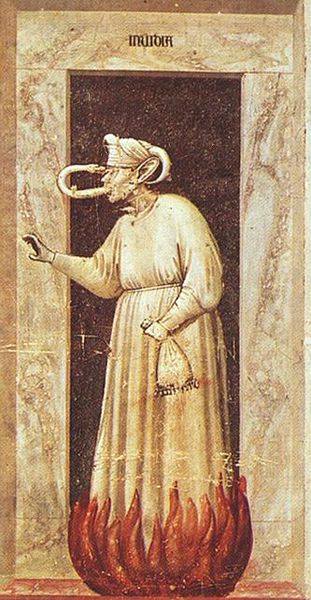Gorgonzola is another stracchino cheese, like Taleggio: it’s made from the milk of “tired” cows, coming down from the highs of their summer grazing in the Alps, on top of the world. (The curious may wish to read my post on Taleggio.) It used to be called “green stracchino,” generically, before it was named “Gorgonzola, “ after its alleged town-of-origin. At my home, we prefer to call it “the weeping green-eyed beast” — an epithet that bears no relation to the Green-Eyed Monster of Envy (that most deadly of deadly sins, “which doth mock the meat it feeds on,” according to Shakespeare, and makes you look like a leek left too long in the sun, according to William Langland).
In addition to the love-stricken swain tale (recited here), Gorgonzola boasts another origin-legend of folly, anxiety, and unexpected redemption. The story goes that a Gorgonzola-area innkeeper dealt in stracchino, before any stracchinos were green; and one day he discovered, to his horror, that much of his cheese stash had fallen ill with a greenish mold. After some deliberation the innkeeper decided — whether out of maudlin desperation or weasel-cunning — to push the green cheese on his customers. He called it a new food masterpiece, a culinary delicacy, a spectacle of local culture; he flourished all the old tricks of the confidence-man cheesemonger. His customers ate, unsuspecting, and they loved it. (They don’t always.) News of the new green cheese spread, and a regional wonder was born.
This would have been somewhere between the 9th and 11th centuries, probably. In the 1950s and 60s, low-quality imitators and foreign devils threatened the reputation of Gorgonzola — as well as the businesses of decent, traditional cheesemakers. So name-protection was granted in 1955 and a Consortium for the Protection of Gorgonzola Cheese was created in 1970. The cheese’s production is now restricted to Lombary and Piedmont; the method (a slightly unusual one) is now standardized, a little industrialized, as much as the Consortium decided it needed to be.
Visit the Consortium’s web page for more information on production — and also, more urgently, to see Italy’s new line-up of Gorgonzola Babes! A collage of photos, fading in and out over the title bar, consists of images you’d expect on the covers of romance novels and Cosmopolitan, images you might want to hide under your mattress. The marketing model for Gorgonzola seems to be “Glamor, Romance, and Cleavage.” Not an uncommon model . . . and no less apt for cheese than for watches and chewing gum, I suppose. Consider this ad I found, a mild example:
I prefer not to know what’s being said. I did find out, though, that “topolona” means “chick” in colloquial parlance, “big female mouse” more literally. “You beautiful big mother of rodents, you. You chubby, cheese-crazed mouse matron. Have some Gorgonzola, my pudgy, bucktoothed, primeval pest. And show me your mammaries — at least the tops, please. Or the sides.”
Gorgonzola can be bought young and sweet, dolce, or aged and piquant, piccante or naturale. I’ve had more experience with the dolce, and it’s a strikingly unique flavor: a lingering blue mold bite; a creamy white paste that melts like ice cream in your mouth; a honey-and-fruit sweetness that hits the higher tones on your palate. I haven’t had other blues much like it. (The closest I have had is a very fine and no less unique American rehashing called Oregonzola, made at Rogue River Creamery in Oregon.)



I second you on being shocked by the many peculiar types of merchandise that certain foreign countries sexualize in their commercials. I once saw an ad for grape juice in Russia that involved a scantily clad woman swooning over a stemmed glass, while the wind ruffled, come-hither, through her hair. I’m pretty sure the message was “No, this isn’t juice. It’s wine.”
I love your site! Have passed it on to my “colleagues” at universita degli scienze gastronomiche, in Parma, Italy, where we are trying to understand cheese among other culinary mysteries….
My introduction to Taleggio was here, where I thought it smelled of hockey gloves, about March, but found that it tasted divine.
Fantastic subjet for a blog. Now I nust get some vintage wine! 🙂